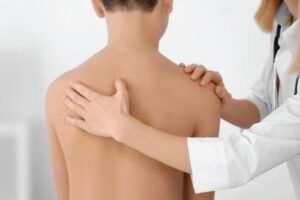Parents, over the summer while at the pool or beach, did you notice your child (while she wore bathing suits or bareback tops), having one shoulder that looked higher, one scapula (shoulder blade), that looked fuller or more prominent, one hip that looked higher than the other, or when bending down, one side of the back looked higher? If so, your child may have early signs of scoliosis.
Scoliosis is a side-to-side curvature of the spine with an “S” or “C” shape to the spine that can occur with rapid spinal growth during adolescence (ages 11 to 14). This condition is seen more often in girls. No one knows what causes the most common form of scoliosis, called idiopathic scoliosis. Adolescent idiopathic scoliosis is the most common spinal deformity affecting adolescents 10 to 16 years of age. This group is frequently referred to a pediatrician as a result of school scoliosis screening programs and concerned parents.
If you ever receive notification as a result of your child’s school screening, don’t be alarmed. Just have your child examined by a pediatrician as soon as possible for confirmation. After examination, your pediatrician may refer your child to a pediatric orthopedic surgeon for evaluation and treatment.
After a thorough head-to-toe exam and X-rays to confirm diagnosis, the pediatric orthopedist will also look at factors related to potential curve progression such as the sex, age and skeletal maturity of the child, along with size of the initial curve, to determine the course of treatment.
Doctors use the “Cobb angle” worldwide to measure and quantify the magnitude of spinal issues, especially scoliosis. Treatment options usually fall into three categories: observation, bracing or surgery.
Observation may be prescribed when a curve is mild, less than 20 degrees Cobb angle, or the child is near skeletal maturity. The doctor will regularly check the child’s spine to make sure the curve doesn’t become any larger.
Bracing may be prescribed when the child is still growing and the curve is greater than 25 degrees Cobb angle. A brace won’t correct an existing curve, but the goal is to slow down or halt the progression of the curve while the child continues to grow. This may help to avoid surgery.
The surgical procedure is called “spinal fusion.” The goal is to fuse the involved vertebrae together in a more normal alignment and to maintain this curve correction throughout adulthood.
Children do most of their growing between the ages of 11 to 14. Therefore, it is important to be screened annually during the time of this peak spinal growth. Early detection and treatment produce the best results. For most children, scoliosis is not a problem. Few children require more than periodic observation.
Children’s of Alabama offers a School Scoliosis Screening Program. For more information, call 205-638-9146.
Quick facts:
Screenings for scoliosis are required by law each year for public school students in the state of Alabama in grades 5 through 9 (ages 11 to 14). What is the screener looking for in the exam?
Standing:
- Uneven shoulders/shoulder blades
- Uneven waist
- Uneven hips
Bending:
- Uneven ribs
- Rounded back





